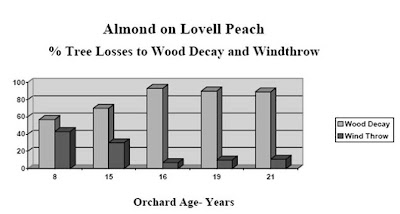Almond Tree Blow-Over Problems
Written by Bill Krueger, UCCE Glenn County
Periodically fall winter or spring storms with associated high winds and saturated soil conditions result in high tree losses. As an example, a March 1995 a storm brought 6 inches of rain and wind gusts up to 100 mph to the Sacramento Valley and resulted in an estimated loss of 15,000 acres of almonds worth $210 million. More recently a storm in January of 2008 with wind gusts in up to 70 mph resulted in tree losses of greater than 30% in some orchards.
When trees fall over their failure can usually be classified as windthrows or wood decay related. Windthrow is when trees with sound healthy roots are uprooted as a result of strong winds and wet soil conditions. Wood decay related failures are the result of infection from wood decay fungi, which consume the lignin in the cell walls of the heartwood. Eventually these trees fall, often in wind storms. Wood decay fungi are secondary pathogens and are not capable of penetrating intact plant membranes and must rely on some type of injury to gain access.
Survey work conducted by Joe Connell, Butte County Farm Advisor and Jim Adaskaveg, UC Plant Pathologist following the March 1995 storm revealed the following. Generally, as trees aged tree losses increased. Windthrow was an important factor in young orchards (Fig.1). As orchards matured wood decay became more dominant. Wood decay accounted for approximately 90 % of the tree loss in mature orchards. Of 394 downed trees evaluated: 77% had wood decay and 81% had crown gall. Crown galls function as sites of entry for wood decay fungi. Generally almonds on Marianna 2624 suffered lower losses than peach rooted trees. The exceptions included orchards in flooded areas with softened soil and unpruned orchards with dense canopies. Generally plum rooted orchards had less crown gall and wood decay.
Generally almonds on Marianna 2624 suffered lower losses than peach rooted trees. The exceptions included orchards in flooded areas with softened soil and unpruned orchards with dense canopies. Generally plum rooted orchards had less crown gall and wood decay.
Suggestions For Reducing Tree Losses From Blow Over Windthrow:
1. Orient strong roots in the direction of prevailing winds.
2. Avoid planting on high berms perpendicular to prevailing winds.
3. Pay attention to the orientation of irrigation wetting patterns particularly with regard to prevailing winds to ensure root distribution which favors anchorage.
4. Planting depth. On well-drained soil, it may be possible to plant plum rooted trees deeper than they were in the nursery. In addition to reducing the number of root suckers this may also provide for better anchorage.
5. Prune to even up variety related tree height differences. Taller trees will catch more wind and are at greater risk.
6. Avoid heading trees to high. Developing tops on high-headed trees will have greater leverage and are at greater risk.
7. Defoliate with zinc sulfate and or prune prior to fall and winter storms to reduce wind resistance.
Suggestions For Reducing Tree Losses From Wood Decay
1.Prevent crown gall. Buy trees from a nursery with a good crown gall prevention program. Treat new trees to prior to planting to prevent infection. Avoid spreading crown gall by injuring crowns and roots and mechanically transferring the disease through practices such as discing, mowing or cutting suckers.
2.Avoid practices which may injure trunks or roots and create an opening for wood decay fungi.
